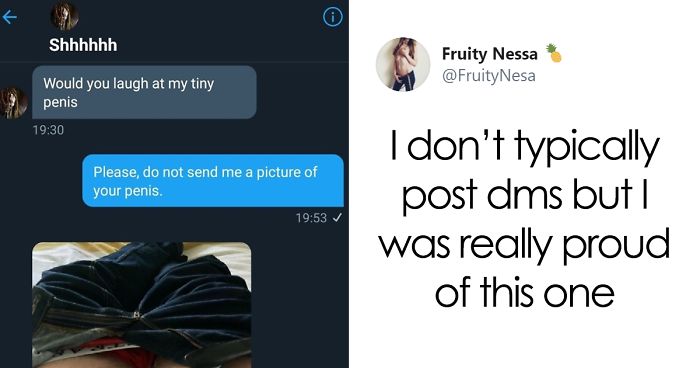
Woman Receives An Unsolicited Pic, Shuts The Creep Down With A Clever Reply
Interview With AuthorThe rise of uninvited sexual images has unfortunately become a fact of life for many young women on social media. A recent YouGov study showed that almost 5 in 10 women (46%) of millennials have received an unsolicited D pic, and they are more likely to have received one the younger they are.
And while we are aware this is not acceptable and essentially humiliating, if you’ve found yourself in this disturbing situation, the words do run dry. But one woman who goes by the Twitter handle @FruityNesa has just come up with probably the most genius way to fight back against internet creeps.
After receiving such an unsolicited pic from a dude who thought it was a good idea, @FruityNesa replied with a staged automated message that made the freak cry for “help.” She then posted the screenshots on Twitter with the caption “I don’t typically post dms but I was really proud of this one,” which blew up immediately with 751.6K likes and 110.5K retweets and comments.
This woman’s viral response to an unsolicited picture has been hailed as genius on social media
Image credits: FruityNesa
Bored Panda reached out to Nesa, the woman behind the viral message fighting back against the internet creep, who preferred to stay anonymous. She told us that over the lifetime of her account, “I received a few unsolicited pictures.”
Nesa came up with the idea to write an automated message in the spur of the moment. “Most unsolicited-pic-senders never listen to what you say.” As soon as she saw his first message, she said she knew the dude was going to send the pic no matter what.
“I had to be sure that he had the cognitive ability to understand my refusal to see his picture. So, I figured I’d write something that would get a clear and deliberate response from him.”
Someone tweaked the staged automated message to make it seem even more realistic
Image credits: moonshinemarsh
Nesa believes that the best way to address and mitigate harassment is to approach it as a collective unit. “Responding to hateful replies under posts may be tiring, but if everyone works together, it becomes less taxing.”
However, Nesa initially received a few misogynistic responses to her post. But before she could get her own words in, others came to her defense. “What’s better is, as the defensive replies from people increased, it triggered the algorithm to boost the harassing comment to the top.”
Other men then saw it and said: “’Whoa. I had no idea this was actually a thing; this is gross. How can I help?’ and that’s when the dominos begin falling in your favor,” she explained.
The author also said that every little detail counts in making the message believable
Image credits: FruityNesa
Image credits: moonshinemarsh
Image credits: PicoterNoob
Image credits: FruityNesa
Nesa truly believes it’s important to expose these people because “there may be more players involved than just you.”
It turns out, after her post went viral, she received a DM from a concerned person who thought this could have been her boyfriend.
“We worked together to gather more information. When they confronted him, he confessed.”Nesa concluded that “If I had ignored his messages, he would have just harassed other women and the dominos would have kept toppling.”
Many people joined the thread to share their views on the matter
Image credits: lemonmartinis
Image credits: jimidragon
Image credits: nich_usde
Many women around the world often face the task of protecting themselves from unwanted attention online and this unfair burden is getting worse as new ways of communication evolve. There has been a recent surge in “cyberflashing” cases, which refers to men sending sexually explicit images via the wireless AirDrop system to devices that carry female names.
In order to protect themselves from AirDrop harassment, some women reported that they renamed their phones to male names, like “John’s work iPhone.”
Laura Thompson, who investigates online abuse and harassment, believes that “these things have always been a problem, there has always been sexism, and men who abuse power and abuse women, and this is just another way to do it.”
Image credits: BretMeasor
Image credits: ZaneWeebDrip
Image credits: TakeTheLBitxh
Unfortunately, there are no universal sexting laws across the US, and state laws are either not very well defined or vary widely.
While the Harmful Digital Communications Act (HDCA) “makes it illegal to post a digital communication with the intention of causing serious emotional distress to someone else,” it counts only if you’re sending multiple sexually explicit images to a person who hasn’t agreed to it, or if the receiver is a minor. When sexting involves minors, it violates both state and federal child pornography laws.
Image credits: schmo_flo
Image credits: KristiCharlie
Image credits: BronySumummon18
Image credits: Jaynesharp
Image credits: lukesmithapps
Image credits: TrestonLiz
Image credits: perrigame
Image credits: Cam_Lee_Beauty
Image credits: chetawesomelasr
Image credits: false_daylight
Image credits: Its_BlackFire
Twitter should have this for real. And then actually report it to police. These guys don't actually think women like being sent these pics. They know it's harassement and that's why they do it.
You expect them to care. Spoiler alert: they don't
Load More Replies...Let's be honest and clear about this kind of s**t: unsolicited d**k pics are sexual harassment. It is the online equivalent of indecent exposure (aka flashing), and should be outlawed just the same as indecent exposure. It's not cute. It's not funny. It's not okay. It should not be f*****g "normal" or expected to happen and the response should be an aggressive "STOP SENDING UNSOLICITED D**K PICS" and not "block and move on lol" because the latter does NOTHING. We shouldn't have to "block and move on lol" because creeps like this shouldn't be sending them in the first place. And while I am aware it's not just men sending unsolicited images like this to women, and the inverse can be just as true, you hear way more about guys doing this to women than vice versa. But either way, unsolicited nudes being sent to random strangers needs to stop and die off.
Who ever wants them anyway? Has this ever worked for any man?? "Do you want to go out?" no. "have sex?" No. " coffee?" No. *d**k pic* ... Well, now! 🙄
Load More Replies...Never having sent (or received) a d**k pick I am wondering - how does a conversation escalate to that point? Isn't there a lead-up during which there is plenty of time to block the user? Or are these d**k-pick senders long time acquaintances? Is the pic sent as a second message after "hello how are you"? How does this work? Where do you find these people who end up sending their d**k pics?
Not always. I've had them from co workers and acquaintances but I've had friends get them from dating sites. To be clear, they are never wanted unless asked. Even then it's, eh. It's ugly lol. No matter how pretty, still ugly.
Load More Replies...Not sure how some guys still haven't figured it out... If their faces couldn't pull a girl, their d**k has absolutely ZERO chance lol
It's not only the faces that count. Sending unsolicited d**k pics is a pretty strong warning signal.
Load More Replies...If a guy exposes his penis in public he can be arrested, charged, and likely labeled a sex offender. Doing this on the internet is literally the same thing. Why can’t we start labeling them sex offenders too?
Right now three top-most comments by Martha Meyer, Electric Ed, and Malakai have 12, 5, and 4 upvotes, respectively, but they are hidden an no one can answer. Does this have anything to do with that new feature were you get warned that a similar sounding comment previously has been downvoted? There are so many problems with that feature and in case my assumption is correct these upvotes prove that its implementation is problematic. (Of course I also got asked whether I want to post this. Bored Panda stopped to be funny.)
I got exactly the message you described before I posted. It's weird!
Load More Replies...@Electric Ed - men who send d**k pics frequently don't bother to have a conversation first. They usually start with "hi", and then if the recipient answers, MAYBE the d**k senders use some stupid introduction before they spread their junk around. Like the guy in this post asked if the woman wanted to see his "tiny penis" and then ignored her telling him no. The thing is, unsolicited/unwelcome d**k pics are just as much about the power of violating another person's autonomy as any other form of sexual assault. It's really not different from groping someone on the train or jerking off in public.
This is so well put. I wish I could give you more upvotes.
Load More Replies...Well now they'll all know this trick. Somebody needs to make an algorithm that recognizes these pics and flags them. Or, once the source is recognized, change all of their profile pics to their di*k pics. Imagine applying for a job and your Indeed profile pic is a d*ck.
Or if one user literally writes the words 'don't send a d*ick pic', or something to that effect, then another user has sent a picture immediately before or after that comment... it should automatically get flagged for review. Or, hell, the victim could write 'REPORT @(user)', and that would flag it. If one user is found to have sent an unsolicited picture, they should be reported, possibly fined, have a suspension or a ban. End of story. This c**p has to stop. Naturally, companies don't want to be bothered since this is a problem that mostly effects women.
Load More Replies...@chi-wei it's happening because the filter apparently has been ramped up in strictness. I can't even type innocuous words like gla*sses without the warning. Any words containing a*ss (like gla*sses, hara*ssment, embarra*ss, etc) or other "swears" that are just part of the spelling are being automatically censored. It's ridiculous
Yesterday, I posted a comment about an engineering class that was blocked. Thank you for explaining that the word class is offensive.
Load More Replies...This will only work for a few days and than all those creeps will know about it. Perhaps social media should have a "report" button which will automatically send all the relevant info plus the d**k-pic to some authority. I mean, they can sell all your private data to various "partners" so they surely can send "privates" to the police.
Sgree, same goes for other kinds of nastiness online
Load More Replies...I never understand the concept of d**k pics. Male genitalia is not attractive, even the best looking guys I've met have a penis which looks like a sad slug. Honestly do men believe girls want to look at the ugliest part of their body, not trying to insult anyone out there but I do wonder who thought explicit pictures of their dangly bits might actually attract anyone.
Every woman I've ever talked to about this has gotten an unsolicited d**k pic. While I don't think every man has sent one, some of you guys obviously have much to say about little.
I have an entire folder of pictures of inflamed buttholes. I send these carpet-bomb style whenever I get a UDP
@Dean Doe Genuine question- is this from your personal experience? A lot of women aren't into that, possibly due to them not having a g-spot in that place. Personally I'm led to believe that you've never been within 20 feet of a woman or are some sort of troll with nothing better to do, but to cover all bases, I'm aware that you might just be a very sheltered gay man.
PotatoNinja - I think Doo Dean is the new user name for a previous user who enjoys posting about lesbians. A lot. I think the comments are either a cry for help, or a strange desire to insult lesbians to random people on the internet. Either way, I always upvote their posts, as they seem to need the validation (or invalidation.)
Load More Replies...Some men don't know what NO means or how to not be disgusting sexual predators in general. You say "I’m married" they say "oh what you can't have any friends?" "He doesn't have to know". You say "Sorry I only date women" they say "you sure? I can change that" "you just haven't met the right man yet". You say "I’m not interested in explicit pics" they *send it anyway* It's just never ending.
We shouldn't need to do that. We should be able to immediately click on an option that reports the image and the user to the platform and the police if appropriate simultaneously along with the recent conversation to make it clear if something was solicited or not. It is harassment of the worst kind. Both parties will then be sent a notification of the report. Then action has to be taken by the platform.
I have never for the life of me understood why some men do this. What is the point of sending an unwanted d**k pic? Do they really think the woman (or man) on the other end is just going to be like "oh baby yes! Come here!"? Its especially annoying after a woman has already said no and that they weren't interested. If she already wasn't interested before, what makes you think she'll be interested in unwanted sexual harassment? I have never in my life heard of a woman sending random vagina pics to men (or other women).
" I have never in my life heard of a woman sending random vagina pics to men (or other women)." And if this would become a fad, done en masse - what would happen?
Load More Replies...Malakai said, "Let's be honest and clear about this kind of s**t: unsolicited d**k pics are sexual harassment." YES! YES! Guys, stop. Just stop.
I just don’t get it. Why tf would you actually want to send an unsolicited picture of your penis? Like... when is it ever a good idea? Even if she asks for it, like... why? HOW? Explainnnnnnnnnn
Sending a picture of your genitals whether you are male or female is just plain stupid. Especially if the person didn't ask you to send it. I don't understand these people who think that it is appropriate to send photos of themselves like that. Once you send a photo like that, it's out there forever and if the person is vindictive enough they might post it somewhere. Think before you expose yourself like that.
Does anyone else see this behavior as a lily-livered, p**s-poor, passive aggressive form of rape?
There's some deeper humor here that nobody has mentioned... There is no 42 USC §1283, but if there were, It would fittingly be in Title 42 (Public Health and Welfare), Chapter 7 (Social Security), Sub-chapter 10 (Grants to States for Aid to Blind). It's both a vaguely legal-sounding threat and a burn.
Ok a little confused. I looked at the picture above in the screenshot and it just looks like his clothes and not a dic pic. Or before it was posted on this website was it edited or covered up?
This and girl gamer bullying are why I started using a male name online.
Unsolicited pics are never ok and should be punishable. Some men just don't know how to take no for an answer. You can literally tell a man you're lesbian and their first reaction is to not believe you. Like bro there are only 2 scenarios that can play out here, neither in your favor either 1. I really am a lesbian or 2. I am so uninterested in you I lied about my sexuality for you to leave me alone.
Good for her 🙌 - hope the creep gets scared for life and doesn't send an unwanted d**k pick again Also, there needs to be a way to report these messages to Twitter or the phone service provider - maybe come up with a system where the mobile phone provider tracks down the d**k pick person and the police give them a fine or community service.
I don't agree with the above answer as to why some people do that. Sometimes it's a display of masculinity, but sometimes its a form of self-abasement, self-shaming. Other times (like a commenter here noted) it's the same as indecent exposure. In any case, whatever the motive, it's sick and disgusting.
Take the pic he sent and enter Photoshop and make a few... Adjustments. ;)
Sending d**k pics isn't "toxic masculinity" it's called being an idiot. Great way to deal with it tho
When there are more Male idiots than female ones, you’ve got to start asking why.
Load More Replies...I have heard that more people are likely to appreciate an unsolicited "dik-dik pic" but caution applies as usual ;-)
Bearing in mind that a lot of men on dating sites are using bots or agencies to manage the early engagement in order to secure a certain amount of women’s numbers.
By sending dickpicks? I wonder how that works out in the end vs. say sending a face pic?
Load More Replies...It's not about jerks in general, it's about the societal belief that to be a "real" man, you have to adhere to certain behaviours and not others. Like boys being told crying will make them less of a man and that the only emotions they are "allowed" to have are negative ones like anger and rage. It makes people who grow up like that constantly feel on edge that they might be perceived as unmanly/feminine/less, which in turn leads to some super unhealthy behaviour towards themselves and others. Like the guy who told his gf she shouldn't let their baby son mouth at a banana because it looks "sexual" and "gay" (saw that on Reddit a while ago for example).
Load More Replies...Just become a hermit and then you won't have to deal with people!
Load More Replies...The profile picture of @FruityNesa has all of her bits covered. She isn't posting unsolicited vag pics. That is the difference. I don't know how seeing a women's torso is sexual harassment. Women's bodies are often used in advertisements that look just like her picture.
Load More Replies...Twitter should have this for real. And then actually report it to police. These guys don't actually think women like being sent these pics. They know it's harassement and that's why they do it.
You expect them to care. Spoiler alert: they don't
Load More Replies...Let's be honest and clear about this kind of s**t: unsolicited d**k pics are sexual harassment. It is the online equivalent of indecent exposure (aka flashing), and should be outlawed just the same as indecent exposure. It's not cute. It's not funny. It's not okay. It should not be f*****g "normal" or expected to happen and the response should be an aggressive "STOP SENDING UNSOLICITED D**K PICS" and not "block and move on lol" because the latter does NOTHING. We shouldn't have to "block and move on lol" because creeps like this shouldn't be sending them in the first place. And while I am aware it's not just men sending unsolicited images like this to women, and the inverse can be just as true, you hear way more about guys doing this to women than vice versa. But either way, unsolicited nudes being sent to random strangers needs to stop and die off.
Who ever wants them anyway? Has this ever worked for any man?? "Do you want to go out?" no. "have sex?" No. " coffee?" No. *d**k pic* ... Well, now! 🙄
Load More Replies...Never having sent (or received) a d**k pick I am wondering - how does a conversation escalate to that point? Isn't there a lead-up during which there is plenty of time to block the user? Or are these d**k-pick senders long time acquaintances? Is the pic sent as a second message after "hello how are you"? How does this work? Where do you find these people who end up sending their d**k pics?
Not always. I've had them from co workers and acquaintances but I've had friends get them from dating sites. To be clear, they are never wanted unless asked. Even then it's, eh. It's ugly lol. No matter how pretty, still ugly.
Load More Replies...Not sure how some guys still haven't figured it out... If their faces couldn't pull a girl, their d**k has absolutely ZERO chance lol
It's not only the faces that count. Sending unsolicited d**k pics is a pretty strong warning signal.
Load More Replies...If a guy exposes his penis in public he can be arrested, charged, and likely labeled a sex offender. Doing this on the internet is literally the same thing. Why can’t we start labeling them sex offenders too?
Right now three top-most comments by Martha Meyer, Electric Ed, and Malakai have 12, 5, and 4 upvotes, respectively, but they are hidden an no one can answer. Does this have anything to do with that new feature were you get warned that a similar sounding comment previously has been downvoted? There are so many problems with that feature and in case my assumption is correct these upvotes prove that its implementation is problematic. (Of course I also got asked whether I want to post this. Bored Panda stopped to be funny.)
I got exactly the message you described before I posted. It's weird!
Load More Replies...@Electric Ed - men who send d**k pics frequently don't bother to have a conversation first. They usually start with "hi", and then if the recipient answers, MAYBE the d**k senders use some stupid introduction before they spread their junk around. Like the guy in this post asked if the woman wanted to see his "tiny penis" and then ignored her telling him no. The thing is, unsolicited/unwelcome d**k pics are just as much about the power of violating another person's autonomy as any other form of sexual assault. It's really not different from groping someone on the train or jerking off in public.
This is so well put. I wish I could give you more upvotes.
Load More Replies...Well now they'll all know this trick. Somebody needs to make an algorithm that recognizes these pics and flags them. Or, once the source is recognized, change all of their profile pics to their di*k pics. Imagine applying for a job and your Indeed profile pic is a d*ck.
Or if one user literally writes the words 'don't send a d*ick pic', or something to that effect, then another user has sent a picture immediately before or after that comment... it should automatically get flagged for review. Or, hell, the victim could write 'REPORT @(user)', and that would flag it. If one user is found to have sent an unsolicited picture, they should be reported, possibly fined, have a suspension or a ban. End of story. This c**p has to stop. Naturally, companies don't want to be bothered since this is a problem that mostly effects women.
Load More Replies...@chi-wei it's happening because the filter apparently has been ramped up in strictness. I can't even type innocuous words like gla*sses without the warning. Any words containing a*ss (like gla*sses, hara*ssment, embarra*ss, etc) or other "swears" that are just part of the spelling are being automatically censored. It's ridiculous
Yesterday, I posted a comment about an engineering class that was blocked. Thank you for explaining that the word class is offensive.
Load More Replies...This will only work for a few days and than all those creeps will know about it. Perhaps social media should have a "report" button which will automatically send all the relevant info plus the d**k-pic to some authority. I mean, they can sell all your private data to various "partners" so they surely can send "privates" to the police.
Sgree, same goes for other kinds of nastiness online
Load More Replies...I never understand the concept of d**k pics. Male genitalia is not attractive, even the best looking guys I've met have a penis which looks like a sad slug. Honestly do men believe girls want to look at the ugliest part of their body, not trying to insult anyone out there but I do wonder who thought explicit pictures of their dangly bits might actually attract anyone.
Every woman I've ever talked to about this has gotten an unsolicited d**k pic. While I don't think every man has sent one, some of you guys obviously have much to say about little.
I have an entire folder of pictures of inflamed buttholes. I send these carpet-bomb style whenever I get a UDP
@Dean Doe Genuine question- is this from your personal experience? A lot of women aren't into that, possibly due to them not having a g-spot in that place. Personally I'm led to believe that you've never been within 20 feet of a woman or are some sort of troll with nothing better to do, but to cover all bases, I'm aware that you might just be a very sheltered gay man.
PotatoNinja - I think Doo Dean is the new user name for a previous user who enjoys posting about lesbians. A lot. I think the comments are either a cry for help, or a strange desire to insult lesbians to random people on the internet. Either way, I always upvote their posts, as they seem to need the validation (or invalidation.)
Load More Replies...Some men don't know what NO means or how to not be disgusting sexual predators in general. You say "I’m married" they say "oh what you can't have any friends?" "He doesn't have to know". You say "Sorry I only date women" they say "you sure? I can change that" "you just haven't met the right man yet". You say "I’m not interested in explicit pics" they *send it anyway* It's just never ending.
We shouldn't need to do that. We should be able to immediately click on an option that reports the image and the user to the platform and the police if appropriate simultaneously along with the recent conversation to make it clear if something was solicited or not. It is harassment of the worst kind. Both parties will then be sent a notification of the report. Then action has to be taken by the platform.
I have never for the life of me understood why some men do this. What is the point of sending an unwanted d**k pic? Do they really think the woman (or man) on the other end is just going to be like "oh baby yes! Come here!"? Its especially annoying after a woman has already said no and that they weren't interested. If she already wasn't interested before, what makes you think she'll be interested in unwanted sexual harassment? I have never in my life heard of a woman sending random vagina pics to men (or other women).
" I have never in my life heard of a woman sending random vagina pics to men (or other women)." And if this would become a fad, done en masse - what would happen?
Load More Replies...Malakai said, "Let's be honest and clear about this kind of s**t: unsolicited d**k pics are sexual harassment." YES! YES! Guys, stop. Just stop.
I just don’t get it. Why tf would you actually want to send an unsolicited picture of your penis? Like... when is it ever a good idea? Even if she asks for it, like... why? HOW? Explainnnnnnnnnn
Sending a picture of your genitals whether you are male or female is just plain stupid. Especially if the person didn't ask you to send it. I don't understand these people who think that it is appropriate to send photos of themselves like that. Once you send a photo like that, it's out there forever and if the person is vindictive enough they might post it somewhere. Think before you expose yourself like that.
Does anyone else see this behavior as a lily-livered, p**s-poor, passive aggressive form of rape?
There's some deeper humor here that nobody has mentioned... There is no 42 USC §1283, but if there were, It would fittingly be in Title 42 (Public Health and Welfare), Chapter 7 (Social Security), Sub-chapter 10 (Grants to States for Aid to Blind). It's both a vaguely legal-sounding threat and a burn.
Ok a little confused. I looked at the picture above in the screenshot and it just looks like his clothes and not a dic pic. Or before it was posted on this website was it edited or covered up?
This and girl gamer bullying are why I started using a male name online.
Unsolicited pics are never ok and should be punishable. Some men just don't know how to take no for an answer. You can literally tell a man you're lesbian and their first reaction is to not believe you. Like bro there are only 2 scenarios that can play out here, neither in your favor either 1. I really am a lesbian or 2. I am so uninterested in you I lied about my sexuality for you to leave me alone.
Good for her 🙌 - hope the creep gets scared for life and doesn't send an unwanted d**k pick again Also, there needs to be a way to report these messages to Twitter or the phone service provider - maybe come up with a system where the mobile phone provider tracks down the d**k pick person and the police give them a fine or community service.
I don't agree with the above answer as to why some people do that. Sometimes it's a display of masculinity, but sometimes its a form of self-abasement, self-shaming. Other times (like a commenter here noted) it's the same as indecent exposure. In any case, whatever the motive, it's sick and disgusting.
Take the pic he sent and enter Photoshop and make a few... Adjustments. ;)
Sending d**k pics isn't "toxic masculinity" it's called being an idiot. Great way to deal with it tho
When there are more Male idiots than female ones, you’ve got to start asking why.
Load More Replies...I have heard that more people are likely to appreciate an unsolicited "dik-dik pic" but caution applies as usual ;-)
Bearing in mind that a lot of men on dating sites are using bots or agencies to manage the early engagement in order to secure a certain amount of women’s numbers.
By sending dickpicks? I wonder how that works out in the end vs. say sending a face pic?
Load More Replies...It's not about jerks in general, it's about the societal belief that to be a "real" man, you have to adhere to certain behaviours and not others. Like boys being told crying will make them less of a man and that the only emotions they are "allowed" to have are negative ones like anger and rage. It makes people who grow up like that constantly feel on edge that they might be perceived as unmanly/feminine/less, which in turn leads to some super unhealthy behaviour towards themselves and others. Like the guy who told his gf she shouldn't let their baby son mouth at a banana because it looks "sexual" and "gay" (saw that on Reddit a while ago for example).
Load More Replies...Just become a hermit and then you won't have to deal with people!
Load More Replies...The profile picture of @FruityNesa has all of her bits covered. She isn't posting unsolicited vag pics. That is the difference. I don't know how seeing a women's torso is sexual harassment. Women's bodies are often used in advertisements that look just like her picture.
Load More Replies...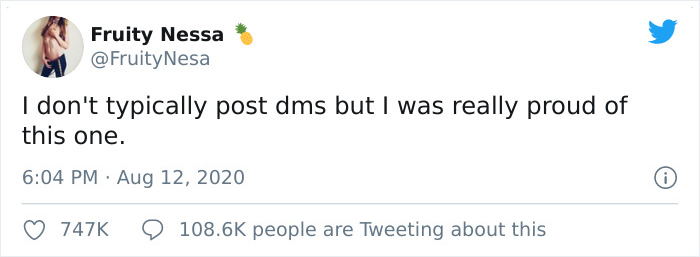

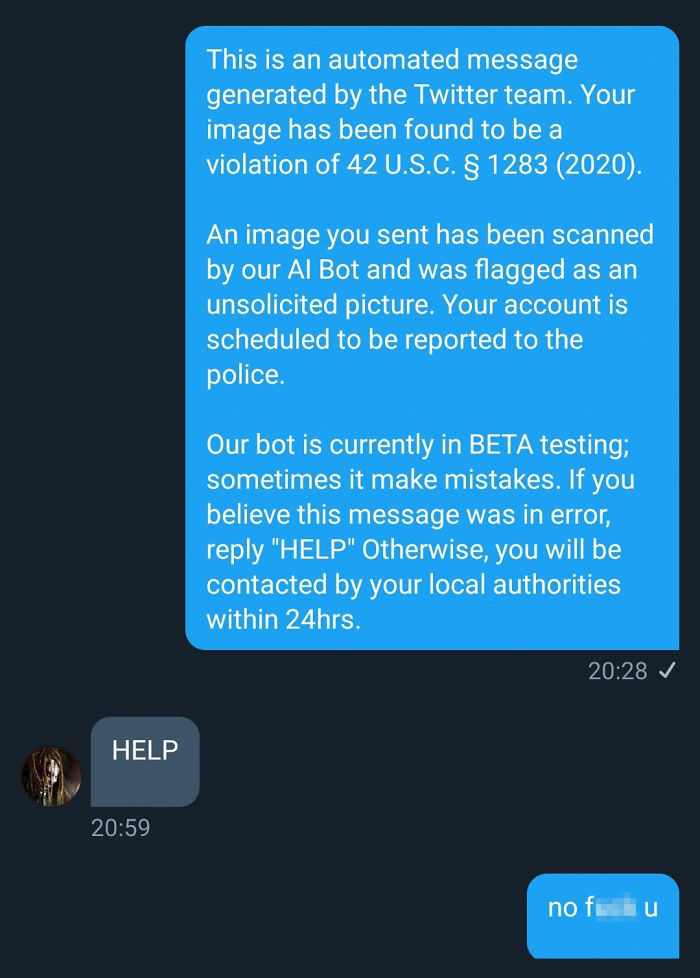
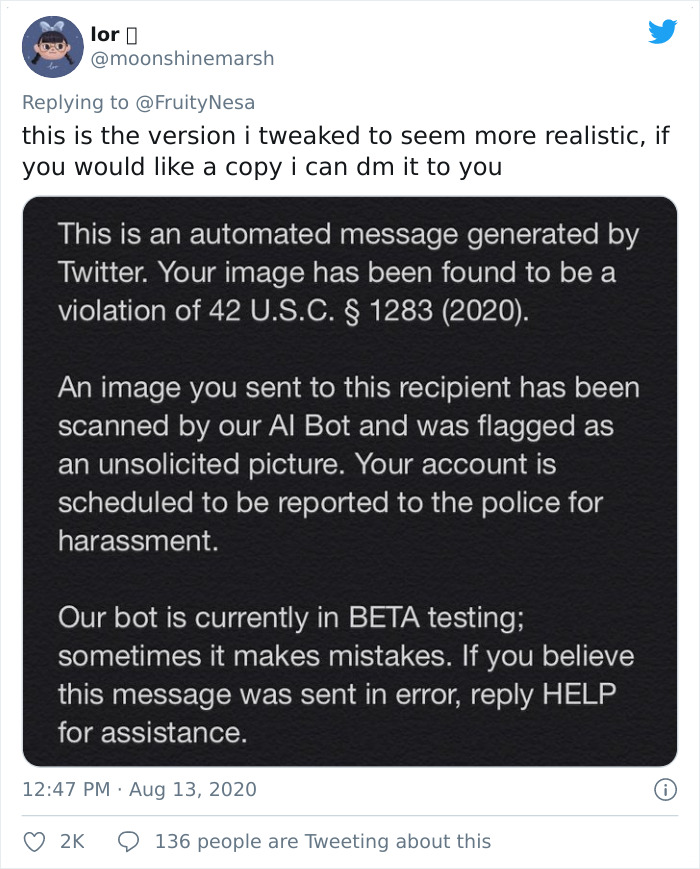
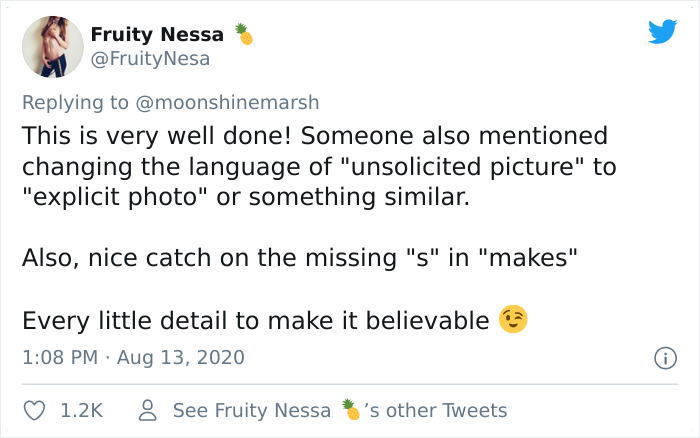
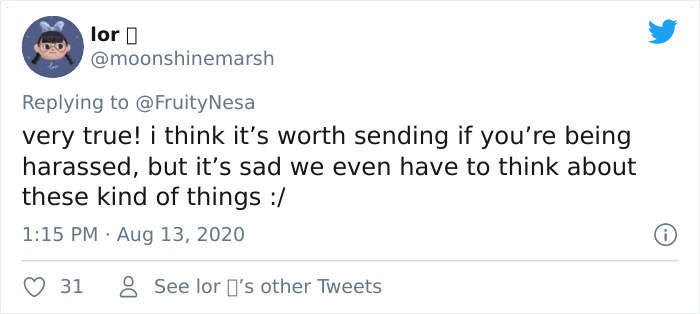
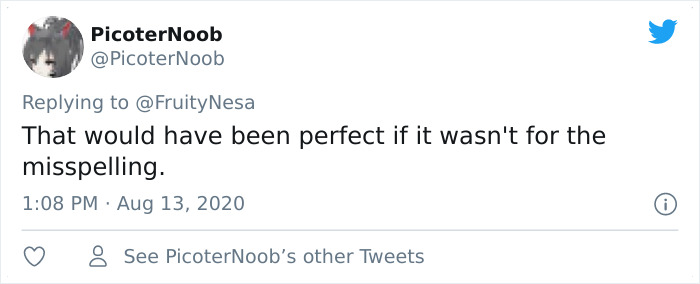
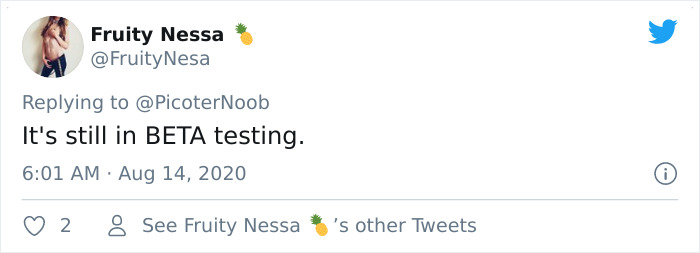
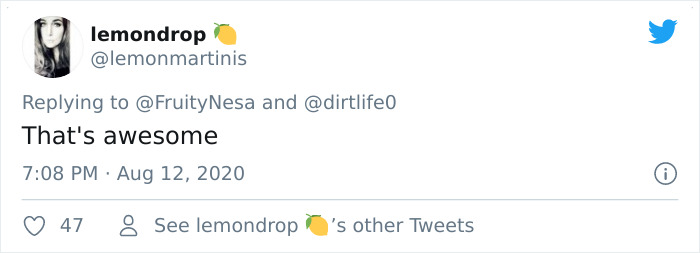
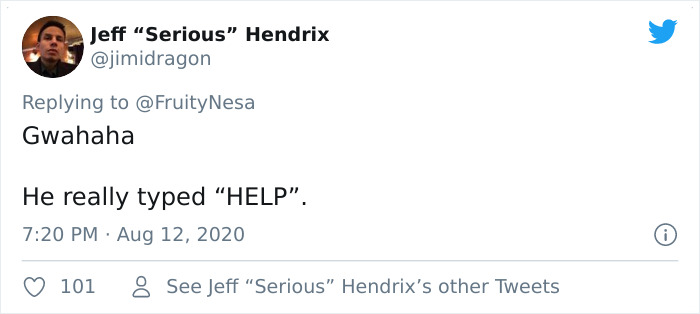
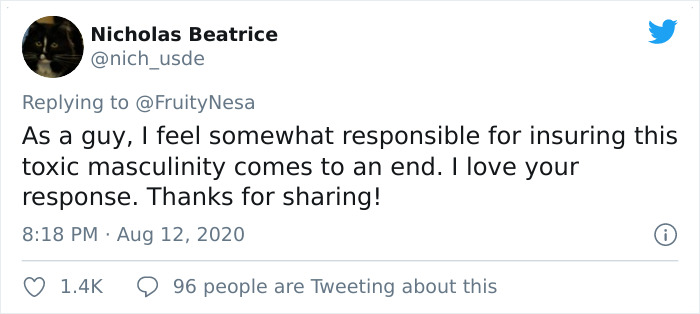
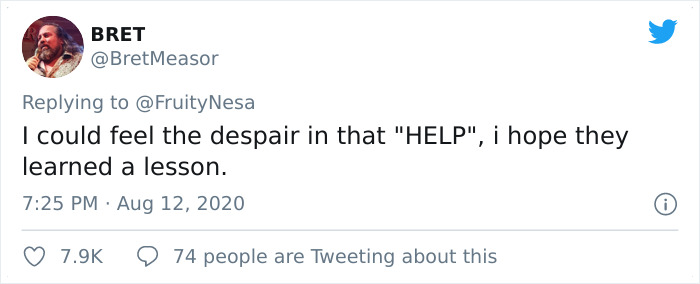


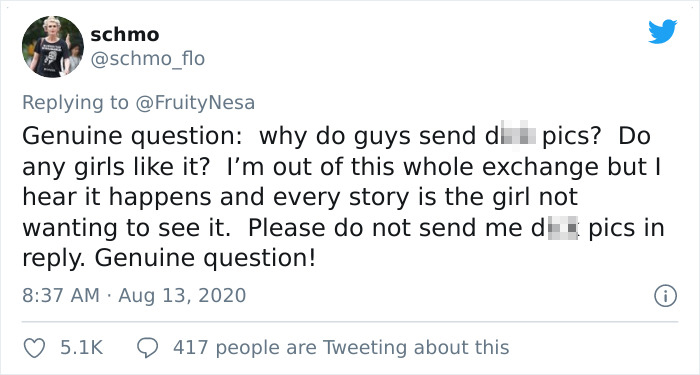

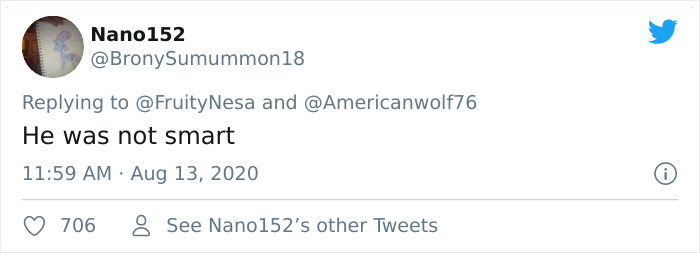
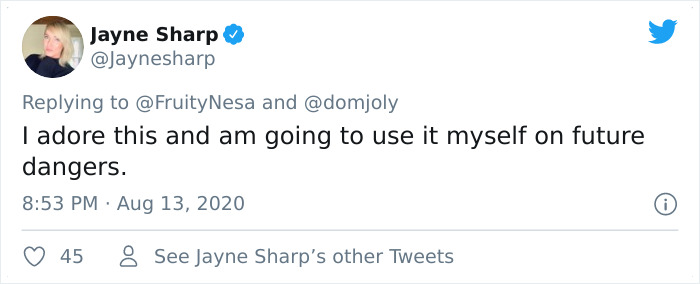
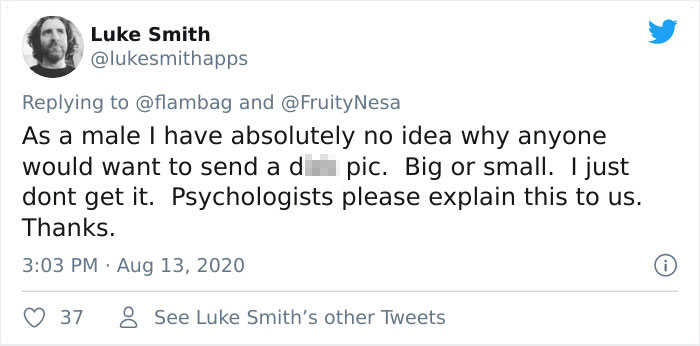
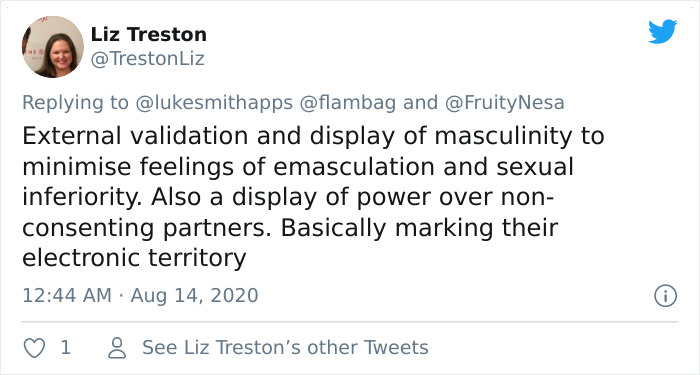
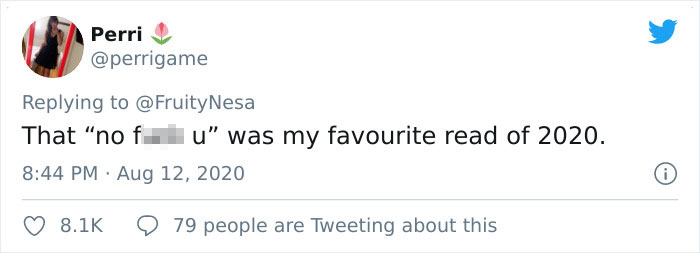
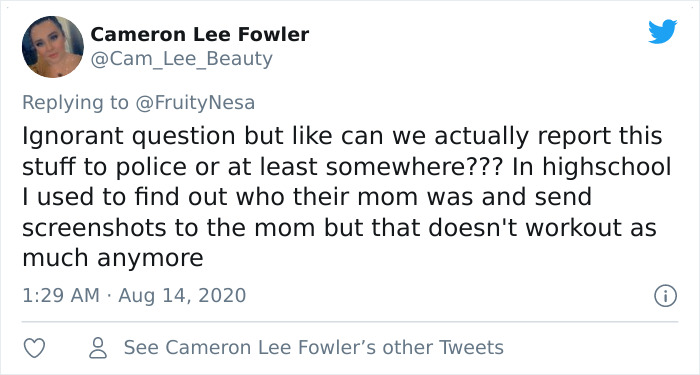
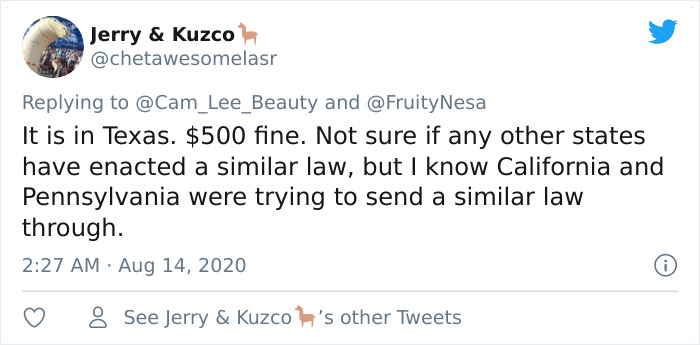
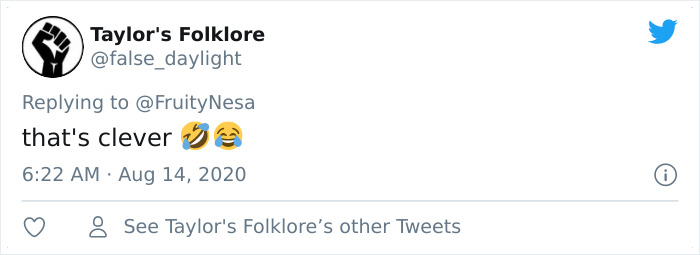
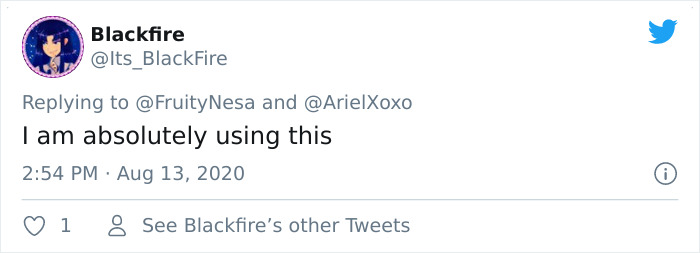




322
131